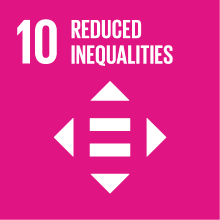ITALIAN SIGN LANGUAGE
- Academic year
- 2023/2024 Syllabus of previous years
- Official course title
- LINGUA DEI SEGNI ITALIANA
- Course code
- LM0016 (AF:441058 AR:249817)
- Teaching language
- Italian
- Modality
- Blended (on campus and online classes)
- ECTS credits
- 6
- Degree level
- Master's Degree Programme (DM270)
- Academic Discipline
- L-LIN/01
- Period
- 1st Semester
- Course year
- 1
- Where
- TREVISO
- Moodle
- Go to Moodle page
Contribution of the course to the overall degree programme goals
The main aims of the course are: i) the acquisition of advanced communicative skills in LIS, ii) the acquisition of the fundamentals of discourse analysis in LIS trhough an in-depth analysis of text linguistics, semantics, pragmatics, and iii) the development of basic translation strategies from LIS to Italian and vice versa.
Expected learning outcomes
- understanding complex texts in LIS of different types and genres;
- knowledge of the lexical, grammatical, pragmatic, and textual elements that can be used to analyze advanced texts in LIS;
- knowledge of the fundamentals of translation theory and practice.
2. Applying knowledge and understanding:
- implementation of the acquired knowledge to understand and analyze complex texts in LIS of different types and registers;
- use of the correct terminology in the description of linguistic phenomena in LIS;
- comparison of linguistic structures of LIS and Italian to be able to plan adequate translation strategies;
- composiition of a linguistic and translation commentary
3. Making judgements:
- making judgments on the well-formedness of LIS data on the basis of metalinguistic considerations;
- assessment of different translation strategies considering the communicative intent and analyzing LIS and Italian structures cross-linguistically;
- evaluation of linguistic similarities and differences between LIS and Italian in a transformative key.
4. Communication:
- clear, accurate, and fluent interaction in LIS in advanced communicative contexts;
- description of linguistic analyses of texts in LIS and cross-linguistic comparisons (LIS/Italian) by means of argumentative strategies and correct terminology;
- interaction with peers, professor and tutor in a critical and respectful way.
5. Learning skills:
- implementation of cross-linguistic comparisons and translation techniques;
- use of technological tools to realize translations from and to LIS and prepare audiovisual materials in an accessible format;
- ability to critically consult the reference bibliography and the lexicographic repertoires that can be used in the translation process.
Pre-requirements
Contents
Theoretical module. The course consists of two parts:
1) description of pragmatic and discourse phenomena of LIS: referentiality and reference chains, discourse analysis, mechanisms of textual cohesion and coherence, figurative language, linguistic registers;
2) cross-linguistic comparison between LIS and Italian and translation strategies. Students will learn basic translation techniques: e.g. technical aspects and accessibility, fundamentals of audiovisual translation, comparison between sequential and simultaneous linguistic strategies, the impact of modality effects on Italian<>LIS translation, approaches to translation, analysis of translation strategies, translation commentary, miscue analysis in translation.
Language practice (for advanced students). The native-signing tutor will present exercises aimed at developing the following language skills:
- LIS poetry: theory and techniques;
- improvement of prosodic competence and facial expressions;
- technical glossary in LIS.
Referral texts
- notes of the lectures and study material provided by the professor (everything will be available in electronic format in the Moodle virtual classroom);
- Calderone C., Cecchetto C. & Mantovan L. (2022). PARTE 6. Pragmatica. In Branchini C. & L. Mantovan (eds.), Grammatica della lingua dei segni italiana (LIS). Venezia: Edizioni Ca' Foscari;
- Celo, P. (ed). 2015. I segni del tradurre. Riflessioni sulla traduzione in lingua dei segni italiana. Ariccia: Aracne;
- Fontana, S. 2013. Tradurre Lingue dei Segni. Modena: Mucchi. —> only Chapter 4, 107-126;
- Danese, L. 2011. La traduzione dall’italiano alla LIS: proposta di accessibilità dei contenuti turistici e culturali. In A. Cardinaletti, C. Cecchetto e C. Donati (eds.), Grammatica, lessico e dimensioni di variazione nella LIS. Milano: Franco Angeli, 231-245;
- Bertone C. (ed). 2013. Pinocchio in LIS. Venezia: Edizioni Cafoscarina, 9-54.
- Tamayo, A. 2022. Sign Languages in Audiovisual Media: Towards a Taxonomy from a Translational Point of View. Journal of Audiovisual Translation, 5(1), 129–149.
- Osimo B. 2011. Manuale del traduttore. Milano: Hoepli.
Language practice (for advanced students)
- lecture notes;
- further study material may be suggested by the tutor during classes.
Assessment methods
i) an audiovisual translation from Italian to LIS accompanied by a critical analysis of the adopted translation techniques;
ii) an audiovisual translation from LIS to Italian accompanied by a critical analysis of the adopted translation techniques.
The final score is the mean of the scores obtained in the examinations related to language practice and the score obtained in the examination related to the theoretical module.
Type of exam
Teaching methods
Moodle virtual classroom.
Language practice (both individually and in groups).
An extensive range of video-recorded material in LIS will be used and analyzed.
Further information
2030 Agenda for Sustainable Development Goals
This subject deals with topics related to the macro-area "Poverty and inequalities" and contributes to the achievement of one or more goals of U. N. Agenda for Sustainable Development




